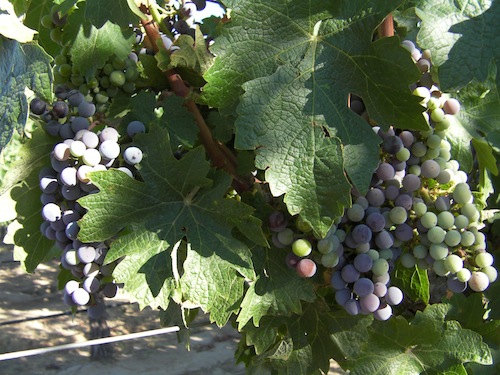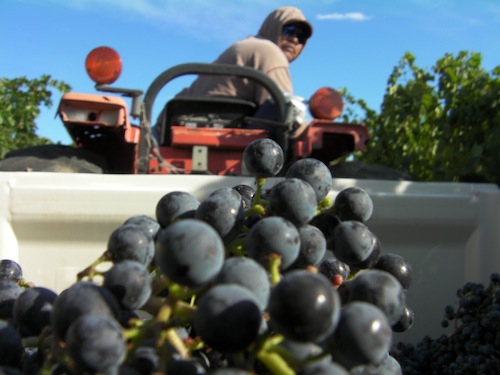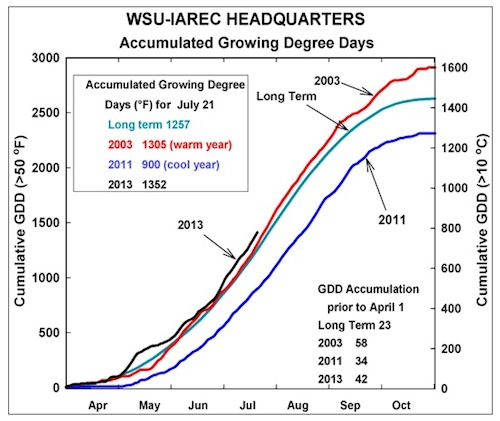
This year’s heat in Washington’s Columbia Valley has grape growers scratching their heads and winemakers scrambling to get ready for what most certainly will be an early harvest.
Last week, Sagemoor Vineyards north of Pasco, Wash., found veraison in Chardonnay and Syrah. Veraison is a French word for “change” that signals when grapes begin to soften and change color. To growers and winemakers, veraison begins the countdown to harvest.
In typical years, veraison often shows up the first week of August in the Columbia Valley. But this year, it’s early – just as everything else has been since bud break in early April.
“We hit bud break two weeks ahead, hit bloom two weeks ahead, and now veraison is two weeks ahead,” said Kent Waliser, general manager for Sagemoor.
Veraison could signal early harvest this year

Winemakers are buzzing about veraison, noting harvest could start as early as Sept. 1
Charlie Hoppes, owner/winemaker at Fidelitas Wines, told Great Northwest Wine that it is not unprecedented to harvest so early in Washington – though it hasn’t happened in awhile.
“I can remember picking red grapes on Labor Day before,” he said. “It makes it a little tougher because we’d like a bit more hang time, but sometimes it happens.”
Hoppes, who has been making wine in Washington for more than a quarter-century, said he can recall being done with the 1995 harvest by mid-October.
“That was kind of nice,” he said.
With his increased focus on Red Mountain – traditionally Washington’s warmest viticultural area – Hoppes is beginning to gear up for harvest, which could start as little as five weeks from now.
By the numbers, 2013 could be hottest yet

Waliser pointed out that this year’s heat is on track to exceed 2003, which has been the benchmark for hot vintages. According to Washington State University’s research station in Prosser, the Yakima Valley had 1,362 heat units as of Sunday, July 21. The average long-term heat units by July 21 are 1,257, while 2003 was 1,306.
Meanwhile, 2011 – now the benchmark for cool vintages – had just 900 heat units by July 21.
Heat units, or cumulative growing degree days, are a measurement of how warm temperatures are from April through October. They are figured by subtracting 50 from the average daily temperature. Heat units do not take in all factors. For example, grapevines will stop performing photosynthesis at about 95 degrees. Instead, they will “shut down” to protect the plant. Thus, when temperatures hit 103 – as they did Monday in the Columbia Valley – the vines do not actually ripen fruit for much of the day.
This year, the three warmest areas of Washington wine country are, in order, the Wahluke Slope, Red Mountain and Maryhill, followed closely by Ancient Lakes (a traditionally cooler area) and the Horse Heaven Hills.
Purple grapes at Champoux Vineyards

Paul Champoux, owner of Champoux Vineyards in the Horse Heaven Hills, said he has not noticed veraison in any of his early varieties yet – with one exception.
He planted a half-acre of a red hybrid grape called Marquette, which was developed by the University of Minnesota. It is a distant relation to Pinot Noir and also is a cousin of a grape called Frontenac. It can handle below-zero temperatures typical of upper Midwest winters and is in high demand in that area of the country.
Champoux planted it on a whim because he attended Marquette High School in Yakima. He told Great Northwest Wine that his Marquette grapes are fully purple and a sugar reading he took Monday indicated they already are at 19.1 brix, not far from optimal ripeness of 24-25 brix.
He said Hoppes plans to make the wine for him, though he’s not sure what he will do once it’s bottled.
“I’ll have to figure out what to do with that,” Champoux said. “If nothing else, I’ll be able to sell it to the guys I went to school with.”
Because the berries already are sweet, Champoux has had to take unusual precautions with his Marquette.
“It’s the only thing ripe in the whole county, so I had to net it because the birds were eating it,” he said with a chuckle.
Early ripening a concern for winemakers, growers

One potential issue with an early harvest is grapes becoming “sugar ripe” before their flavors develop, something winemakers don’t like because they hope to avoid too many green characteristics. Hoppes said this might be a good year for vineyards to carry higher tonnage to balance the fruit that is on the vine.
“I would prefer higher crop loads and more hang time, especially on Red Mountain, where it’s so hot,” he said. “I have no problem carrying 4 tons of Merlot (per acre).”
Some of these decisions will be made at veraison, when growers typically will begin to cut off some clusters to ensure the remaining grapes ripen properly.
“This might be the perfect year to carry more crop and a year for growers to maybe make a bit more money,” he said. “It’s not really going to affect quality (to have higher crop loads), especially on warmer sites.”
Waliser, who as a grower would not mind making a bit more money, said that unfortunately it isn’t a simple equation. Many contracts between growers and wineries are written in a way that specify how many tons per acre vineyard blocks can carry. He said wineries already have figured out how much tank space they have and how many barrels they’ll need. And they also need to look one to three years ahead to project sales.
“I think this is going to create a tight situation,” Waliser said. “We might find ourselves raising the very best fruit but getting tight on space at the end. We’re all speculating, playing Monday morning quarterback before the game even starts. There’s no shortage of people trying to guess this one.”
Waliser, whose vineyard is in one of the warmest areas of the Columbia Valley, said this well could be a year in which cooler regions such as the Yakima and Walla Walla valleys shine because they won’t struggle to ripen their grapes.
“Every variety in every area will be different (than prior vintages),” he said. “Whether that will be good or bad remains to be seen.”

Leave a Reply